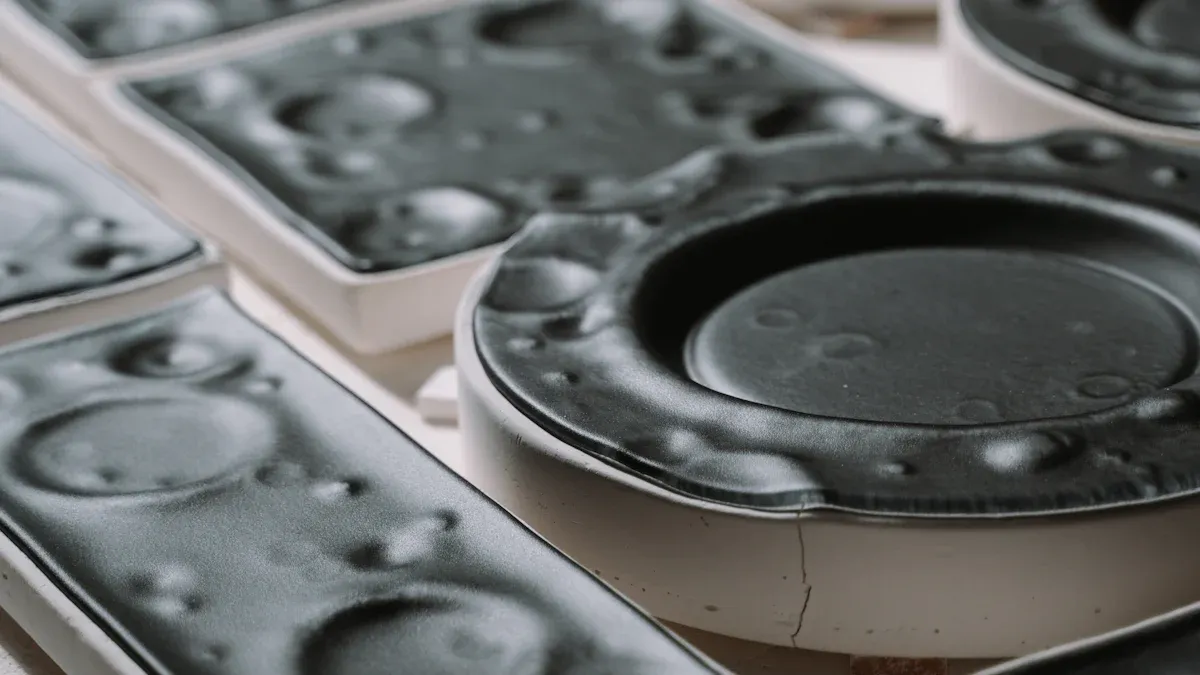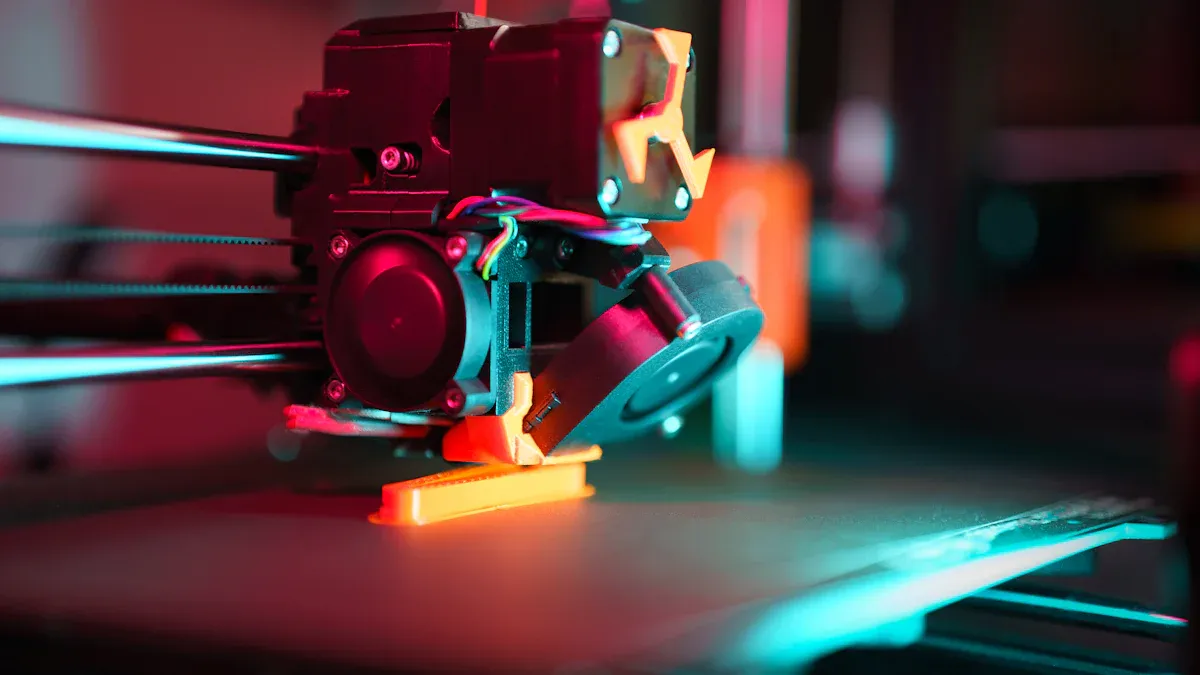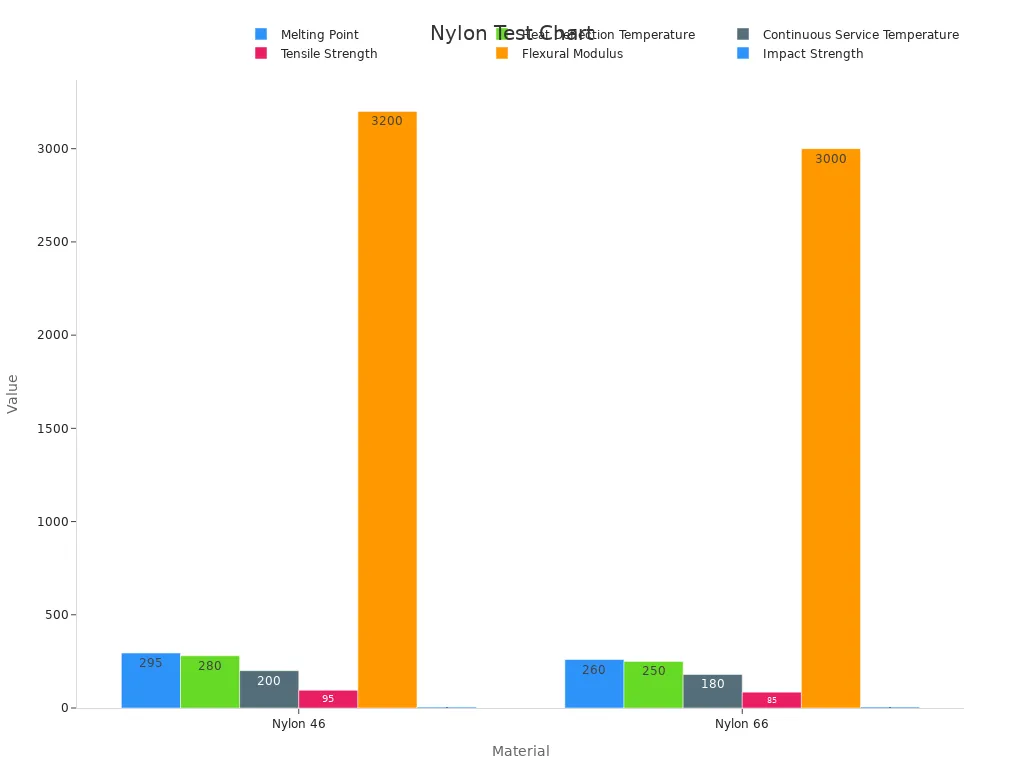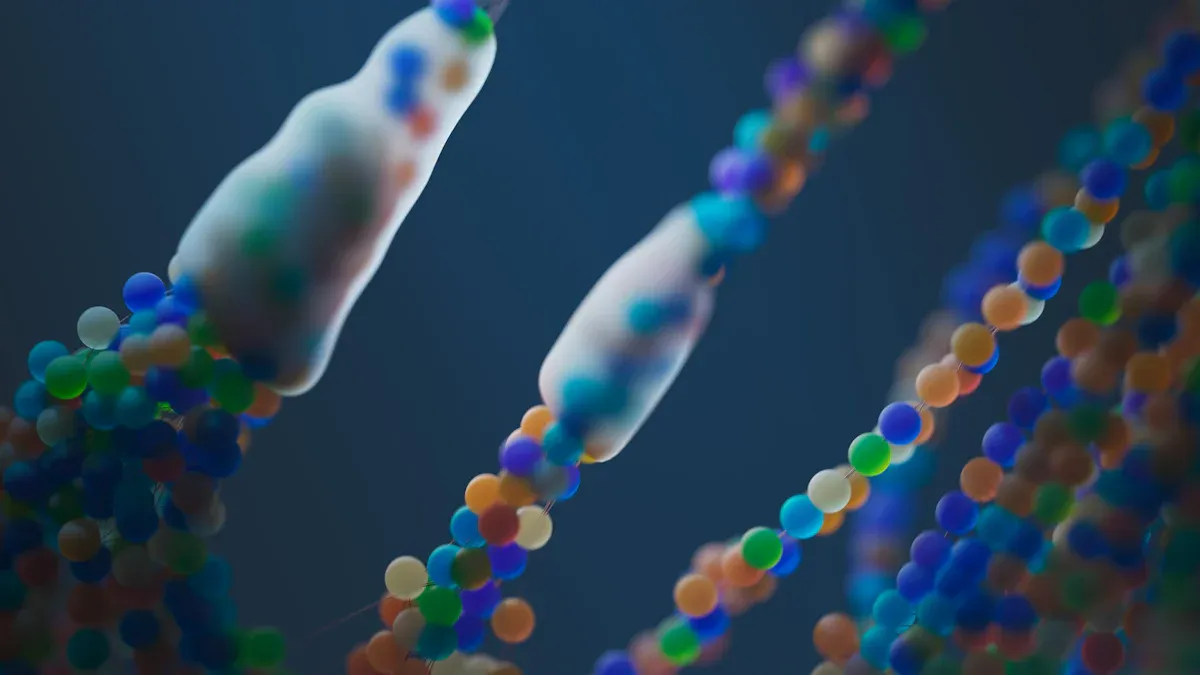
Advanced polymers are shaping the future of manufacturing, offering unmatched possibilities in injection molding. These materials, such as PEEK and Nylon, bring exceptional strength, heat resistance, and chemical stability to the table. You can find PEEK excelling in aerospace components and Nylon thriving in automotive parts due to their unique properties.
With advanced polymers, industries now achieve greater precision, durability, and efficiency in their products.
Their applications continue to expand, proving their transformative role in modern manufacturing.
Advanced polymers are materials engineered to deliver superior performance in demanding applications. Unlike conventional plastics, these polymers exhibit enhanced properties such as high strength, heat resistance, and chemical stability. They are designed to meet the needs of industries like automotive, aerospace, and healthcare.
You can classify advanced polymers into several categories based on their structure and functionality:
- Plastics: Rigid materials that maintain their shape under stress.
- Rubbers: Flexible materials with excellent elasticity.
- Thermoplastics: Polymers that can be reshaped when heated.
- Thermosets: Crosslinked polymers that retain their form permanently.
- Composites: Polymers reinforced with fillers for added strength.
| Type of Polymer | Description |
|---|---|
| Nylons | Polymers with functional groups, ideal for durable applications. |
| Polyesters | Functional group polymers used in textiles and packaging. |
| Polyurethanes | Versatile polymers with applications in foams and coatings. |
These classifications highlight the versatility of advanced polymers, making them indispensable in modern manufacturing.
Injection molding relies on advanced polymers to produce high-quality, durable components. These materials enable manufacturers to achieve precision and efficiency in their processes. The global injection molding materials market reflects this growing demand, with a projected compound annual growth rate (CAGR) of 5.8% from 2024 to 2032. In 2023, the market was valued at $265 billion and is expected to reach $451 billion by 2032.
Several factors drive this growth:
- The need for lightweight and durable components in industries like automotive and aerospace.
- Rising consumer preference for sustainable materials, such as bioplastics.
- Advancements in injection molding technologies, including rapid heat cycle molding and conformal cooling channels.
For example, the adoption of conformal cooling channels has minimized warpage and improved dimensional stability in molded parts. This innovation demonstrates how advanced polymers enhance both product quality and manufacturing efficiency.
By leveraging these materials, you can stay ahead in a competitive market while meeting the demands of modern consumers.

PEEK, or polyether ether ketone, is a high-performance polymer known for its exceptional mechanical and thermal properties. It stands out as one of the most versatile materials in injection molding due to its ability to maintain strength and stability under extreme conditions. You can rely on PEEK for applications that demand durability and precision.
Here are some key material properties of PEEK:
- High temperature resistance: PEEK can withstand injection temperatures up to 380°C, making it suitable for high-heat environments.
- Mechanical strength: With an average tensile strength of 96.4 MPa and bending strength of 147.65 MPa, PEEK delivers excellent performance under stress.
- Chemical resistance: It resists a wide range of chemicals, including acids like sulfuric and nitric acid, even at elevated temperatures.
- Wear resistance: PEEK offers outstanding abrasion resistance, making it ideal for components in continuous motion.
- Flame resistance: It has a UL 94 V-0 flammability rating, ensuring safety in high-risk environments.
- Biocompatibility: PEEK is FDA-approved for food contact and can be sterilized, making it suitable for medical and food-related applications.
| Property | Description |
|---|---|
| High chemical resistance | Effective even at elevated temperatures. |
| High hardness, stiffness & strength | Provides excellent mechanical performance. |
| Excellent fatigue & stress-crack resistance | Ensures durability under repeated stress. |
| Resistance to high pressure water & steam | Maintains integrity without significant degradation. |
| Sterilization capability | Can be sterilized via autoclave, making it suitable for medical applications. |
| Easy to machine & fabricate | Facilitates manufacturing processes. |
| UL 94 V-0 flammability rating | Indicates good fire safety performance. |
| Low smoke/toxic gas emission | Minimal harmful emissions when exposed to flame. |
| Continuous use temperature | Suitable for applications up to 338°F/170°C. |
| FDA-approved for food contact | Safe for use in food-related applications. |
PEEK material properties make it a top choice for industries requiring high-performance polymers. Its ability to maintain mechanical and chemical integrity under extreme conditions ensures reliability in critical applications.
PEEK's unique properties open the door to a wide range of applications across various industries. Its versatility allows manufacturers to create durable, high-precision components that perform well in challenging environments.
Some common applications of PEEK include:
- Medical devices: PEEK's biocompatibility makes it ideal for spinal implants, dental components, and surgical instruments. It can also be used in pharmaceutical tube fittings for dispensing and testing processes.
- Aerospace and automotive: PEEK maintains its mechanical properties at high temperatures, making it suitable for engine components, seals, and other parts exposed to extreme heat. Its wear resistance also benefits components in continuous motion.
- Electronics and semiconductors: PEEK's chemical resistance and low smoke emission make it a reliable choice for microinjection molding components and micro PEEK housings.
- Oil and gas: PEEK's durability and resistance to harsh chemicals ensure long-lasting performance in extreme environments.
- Food industry: PEEK's FDA approval for food contact and chemical inertness make it suitable for food processing equipment.
| Metric | Value |
|---|---|
| Average Tensile Strength | 96.4 ± 2.28 MPa |
| Average Bending Strength | 147.654 ± 9.36 MPa |
| Impact Strength | > 10 kJ/m² |
| Minimum Bending Strength | 110 MPa (ISO 178) |
| Minimum Flexural Modulus | 3 GPa (ISO 178) |
| Minimum Notched Impact Strength | 4 kJ/m² (ISO 180) |
For example, in the aerospace sector, PEEK has been used to address critical product failures by providing durable and lightweight solutions. Its ability to withstand extreme environments minimizes replacement frequency, saving time and costs.
PEEK's applications continue to grow as industries recognize its potential to improve product performance and reliability. Whether you're designing medical implants or automotive components, PEEK offers a solution that combines strength, durability, and precision.
Nylon stands out as a versatile and high-performance polymer in injection molding. Its unique properties make it a preferred choice for creating durable and lightweight components. You can rely on nylon for applications that demand strength, flexibility, and resistance to wear.
Key properties of nylon include:
- High-temperature resistance: Nylon retains its mechanical properties even at elevated temperatures, making it suitable for demanding environments.
- Low melt viscosity: This property allows nylon to flow easily into intricate mold designs, reducing injection pressures and improving production efficiency.
- Fatigue resistance: Nylon endures repeated loading cycles without significant degradation, ensuring long-lasting performance.
- Chemical and abrasive resistance: It withstands harsh environments, including exposure to chemicals and abrasive conditions.
To better understand nylon's advantages over other polymers, consider the following comparison:
| Property | Nylon | ASA | POM | PEEK |
|---|---|---|---|---|
| Wear Resistance | Superior | Moderate | Moderate | High |
| Tensile Strength | High | Moderate | Higher | Superior |
| UV Resistance | Low | High | Low | Moderate |
| Aesthetic Performance | Moderate | High | Moderate | Moderate |
| Moisture Resistance | High | Low | Low | Moderate |
| Processing Ease | Easy | Moderate | Difficult | Difficult |
| Cost | Low | Moderate | High | Very High |
Nylon's combination of high wear resistance, tensile strength, and ease of processing makes it a cost-effective and reliable material for injection molding.
Additionally, nylon comes in various grades, such as Nylon 46 and Nylon 66, each offering distinct mechanical and thermal properties. The chart below highlights their differences:

These properties demonstrate why nylon remains a top choice for manufacturers seeking high-performance polymers.
Nylon's versatility allows it to excel in a wide range of applications across industries. Its ability to combine strength, flexibility, and resistance to wear makes it ideal for creating components that perform reliably under challenging conditions.
Here are some common applications of nylon:
- Automotive components: Nylon is widely used in parts like gears, bearings, and shift forks. For example, a 30% glass-filled Nylon 66 was used to create an automotive shift fork that needed to withstand friction, mechanical load, and temperature spikes near 150°C. This solution reduced weight by nearly 30% and lowered production costs while maintaining reliable performance.
- Industrial equipment: Nylon's fatigue resistance and chemical durability make it suitable for conveyor belts, rollers, and other machinery components.
- Consumer electronics: Heat-stabilized nylon is often used in enclosures and housings for devices that require insulation and dimensional stability.
- 3D printing: Nylon's low melt viscosity and strength make it a popular material for creating lightweight and durable prototypes. In one case, heat-stabilized Nylon 66 sheets were CNC-machined to create panels for a 3D printer enclosure. This solution provided lightweight insulation and protected internal components effectively.
- Textiles and packaging: Nylon's flexibility and moisture resistance make it a staple in the production of fabrics, ropes, and food packaging materials.
The table below highlights some successful case studies of nylon in next-generation injection molding projects:
| Case Study | Challenge | Solution | Result |
|---|---|---|---|
| Automotive Shift Fork | Needed to withstand friction, mechanical load, and short-term temperature spikes near 150 °C. | 30% glass-filled Nylon 66 provided stiffness, reduced friction, and minimal wear. | Weight reduced by nearly 30%, lower production costs, reliable performance comparable to metal. |
| Industrial 3D Printer Enclosure | Required dimensional stability and insulation at temperatures around 80–100 °C. | CNC-machined panels from heat-stabilized Nylon 66 sheets. | Lightweight solution that protected internal components effectively. |
Nylon's adaptability and performance make it a valuable material for manufacturers looking to innovate and improve their products. Whether you're designing automotive parts or industrial equipment, nylon offers a reliable and cost-effective solution.
As industries evolve, the demand for materials that outperform traditional options like PEEK and Nylon continues to grow. Emerging advanced polymers are stepping in to meet these needs, offering unique properties tailored for high-performance thermoplastics. These materials are not only addressing performance gaps but also aligning with global trends in sustainability and regulatory compliance.
For instance, regulatory frameworks like the RoHS Directive are pushing manufacturers to reformulate nylon composites, eliminating hazardous substances. Similarly, the EU’s Single-Use Plastics Directive encourages the use of recycled content, especially in automotive applications. This shift has led to the rise of alternatives such as polyphenylene sulfide (PPS) and polyetherimide (PEI), which deliver superior thermal stability and chemical resistance. Manufacturers are also exploring hybrid nylon composites to enhance performance while keeping costs competitive.
| Evidence Type | Description |
|---|---|
| Regulatory Pressures | RoHS Directive drives reformulations in nylon composites. |
| Sustainability Initiatives | EU mandates recycled content in automotive applications. |
| Substitution Threats | PPS and PEI outperform traditional nylons in advanced applications. |
| Cost Considerations | Advanced nylon composites remain cost-effective compared to PEEK. |
| Performance Enhancements | Hybridization improves thermal stability and chemical resistance. |
These trends highlight the growing importance of advanced polymers in addressing modern manufacturing challenges.
Polymer blends are revolutionizing advanced applications in molding by combining the best properties of different materials. These blends allow you to achieve specific performance goals, such as improved strength, flexibility, or thermal resistance, making them ideal for diverse industries.
In packaging, blends of polyethylene (PE) and polypropylene (PP) create excellent barriers to moisture and oxygen, extending product shelf life. For electronics, polycarbonate (PC) and acrylonitrile butadiene styrene (ABS) blends offer toughness and lightweight properties, perfect for portable devices. In the biomedical field, polylactic acid (PLA) combined with polycaprolactone (PCL) ensures biocompatibility for implants and prosthetics, enhancing patient comfort.
| Industry | Example of Polymer Blends | Key Benefits |
|---|---|---|
| Packaging | Blends of PE and PP | Excellent moisture and oxygen barriers, enhancing product freshness. |
| Electronics | Blends of PC and ABS | Toughness and lightweight properties for portable devices. |
| Textiles | Blends of polyester and spandex | Stretchability and durability for activewear. |
| Aerospace | Blends of advanced thermoplastics | Strength and thermal stability for high-performance applications. |
| Automotive | Blends of polypropylene and polyethylene | Impact resistance and aesthetic appeal for safer, fuel-efficient vehicles. |
| Biomedical | Blends of PLA and PCL | Biocompatibility for implants and prosthetics. |
These innovations demonstrate how polymer blends are unlocking new possibilities in high-performance thermoplastics, enabling you to create solutions tailored to specific industry needs.

Advanced polymers deliver unmatched performance and durability in injection molding. These high-performance plastics exhibit exceptional mechanical strength and heat resistance, making them ideal for demanding applications. You can rely on these materials to maintain dimensional stability even under extreme conditions. For example, high-performance thermoplastics like PEEK and Nylon resist wear and tear, ensuring long-lasting engineering thermoplastic components.
Their ability to withstand high temperatures and harsh environments makes them indispensable in industries like aerospace and automotive. By using advanced polymers, you can create manufacturing parts that perform reliably over time, reducing the need for frequent replacements. This durability not only enhances product quality but also minimizes downtime in production processes.
Advanced polymers also offer significant cost and efficiency benefits. Their lightweight nature reduces material usage, which lowers production costs. Additionally, their low melt viscosity allows for easier flow during custom injection molding, improving cycle times and reducing energy consumption.
You can achieve greater precision in manufacturing parts with these materials, minimizing waste and rework. For instance, their dimensional stability ensures consistent results, even in complex mold designs. This efficiency translates to lower operational costs and higher productivity, giving you a competitive edge in the market.
Sustainability is a key advantage of advanced polymers in injection molding. These materials align with sustainability efforts by reducing environmental impact. Life Cycle Assessment (LCA) studies show that advanced polymers contribute to sustainability by minimizing carbon footprints throughout their lifecycle. From production to disposal, they offer a greener alternative to traditional materials.
Recyclable thermoplastics, for instance, support sustainability efforts by reducing waste. You can also explore bio-based polymers, which further enhance sustainability in manufacturing. By adopting these materials, you not only meet regulatory requirements but also contribute to a more sustainable future.
Advanced polymers empower you to balance performance, cost, and sustainability in injection molding. Their unique properties make them a valuable asset for modern manufacturing.
Working with advanced polymers in injection molding presents unique challenges. These materials often require precise handling to maintain their desirable properties, such as chemical resistance and strength. For example, an automotive component manufacturer faced warping issues in large parts. By optimizing cooling and processing parameters, they reduced warping and improved product quality. Similarly, a medical device producer encountered material degradation during molding. Switching to a higher-grade resin and adjusting drying times enhanced material stability and device integrity.
You may also encounter inconsistent shot sizes when using advanced polymers. A consumer electronics manufacturer resolved this issue by implementing real-time monitoring and replacing worn parts. This adjustment resulted in consistent production and fewer defects. These examples highlight the importance of fine-tuning processes to overcome challenges and achieve optimal results.
Recent advancements in machinery and techniques have revolutionized injection molding. Precision and miniaturization have become critical, especially in industries like aerospace and defense, where small, intricate components are essential. Micro injection molding now caters to these demands, enabling the production of high-precision parts.
Overmolding has also gained popularity. This technique enhances the durability and corrosion resistance of plastic parts, making them suitable for harsh environments. Additionally, simulation software has transformed production planning. By optimizing production lines, you can improve efficiency and reduce waste.
Automation and robotics are reshaping manufacturing processes. Automated systems streamline production, ensuring consistent quality and faster cycle times. Techniques like gas-assisted injection molding allow resin to reach intricate mold designs, improving the strength and functionality of final products. These innovations demonstrate how technology is driving efficiency and precision in injection molding.
The future of advanced polymers in injection molding looks promising. Industries are increasingly adopting sustainable practices to reduce environmental impact. Over 40% of the sector now invests in eco-friendly materials and energy-efficient processes. Biodegradable polymers and plant-based materials are gaining traction, aligning with global sustainability goals.
Emerging trends also include the integration of IoT technologies for smart manufacturing. Real-time data monitoring enhances production efficiency and minimizes errors. Hybrid manufacturing, which combines 3D printing with traditional molding, is another exciting development. This approach allows for rapid prototyping and the creation of complex geometries.
As demand for advanced polymers grows, you can expect further innovations in material science. Nanocomposites and hybrid polymer blends will likely play a significant role in enhancing product performance. These trends indicate a bright future for injection molding, with advanced polymers leading the way in innovation and sustainability.
Advanced polymers like PEEK and Nylon have transformed injection molding, enabling you to create durable, high-precision components for industries like medical, automotive, and aerospace. These materials excel in producing complex shapes and miniaturized parts, especially for medical devices where flexibility, biocompatibility, and strength are critical.
Their ability to meet modern manufacturing demands makes them essential for innovation. By exploring these materials, you can unlock new possibilities, improve product performance, and stay ahead in competitive markets. Embrace advanced polymers to shape the future of next-gen applications.
Advanced polymers offer high strength, heat resistance, and chemical stability. These properties ensure durability and precision in molded components. You can rely on them to create lightweight, high-performance parts for industries like automotive and aerospace.
Their low melt viscosity allows for easier flow into molds, reducing cycle times and energy consumption. This efficiency helps you produce complex designs with minimal waste, improving overall productivity.
Yes, many advanced polymers support sustainability. Recyclable thermoplastics and bio-based resins reduce environmental impact. By using these materials, you contribute to greener manufacturing practices and meet regulatory requirements.
Processing advanced polymers requires precise control of temperature and pressure. Improper handling can lead to warping or material degradation. Optimizing your molding parameters ensures consistent quality and reduces defects.
Yes, advanced polymers often outperform traditional materials like metals. Their lightweight nature, combined with excellent resistance to wear and heat, makes them a superior choice for many applications. You can use them to reduce costs and improve product performance.